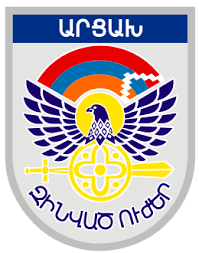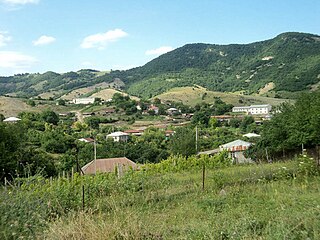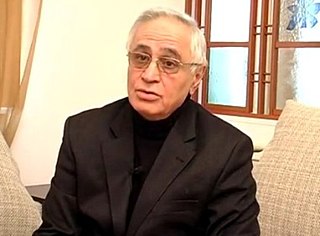
Abulfaz Elchibey was an Azerbaijani politician, Azerbaijani nationalist and Soviet dissident who was the first and only democratically elected President in post-Soviet Azerbaijan. He was the leader of the Azerbaijani Popular Front and played an important role in achieving Azerbaijan's independence from the Soviet Union.

Artsakh, officially the Republic of Artsakh or the Republic of Nagorno-Karabakh, was a breakaway state in the South Caucasus whose territory was internationally recognised as part of Azerbaijan. Between 1991 and 2023, Artsakh controlled parts of the former Nagorno-Karabakh Autonomous Oblast of the Azerbaijani Soviet Socialist Republic, including its capital Stepanakert. It had been an enclave within Azerbaijan from the 2020 Nagorno-Karabakh war until the 2023 Azerbaijani offensive, when the Azerbaijani military took control over the remaining territory controlled by Artsakh. Its only overland access route to Armenia after the 2020 war was via the 5 km (3.1 mi) wide Lachin corridor, which was placed under the supervision of Russian peacekeeping forces.

Rovshan Bakhtiyar oghlu Javadov was an officer in the Azerbaijani Armed Forces and the chief of the Special Purpose Police Detachment of Azerbaijan (OPON).

The First Nagorno-Karabakh War was an ethnic and territorial conflict that took place from February 1988 to May 1994, in the enclave of Nagorno-Karabakh in southwestern Azerbaijan, between the majority ethnic Armenians of Nagorno-Karabakh backed by Armenia, and the Republic of Azerbaijan with support from Turkey. As the war progressed, Armenia and Azerbaijan, both former Soviet republics, entangled themselves in protracted, undeclared mountain warfare in the mountainous heights of Karabakh as Azerbaijan attempted to curb the secessionist movement in Nagorno-Karabakh.

Shahumyan Province was a province of the breakaway Republic of Artsakh, de jure part of the Republic of Azerbaijan. The capital of the province was Karvachar. Shahumyan Province had 17 communities of which one is considered urban and 16 are rural. Its bordered Martakert Province to the east, Kashatagh Province to the south, Gegharkunik and Vayots Dzor provinces of Armenia to the west and Dashkasan, Goygol and Goranboy districts of Azerbaijan to the north.

The Artsakh Defence Army was the defence force of the breakaway Republic of Artsakh. Established in 1992, it united previously disorganized self-defence units which were formed in the early 1990s with the goal of protecting the ethnic Armenian population of Nagorno-Karabakh from attacks by Soviet and Azerbaijani armed forces.
The Battle of Kalbajar took place in March and April 1993, during the First Nagorno-Karabakh War. It resulted in the capture of the Kalbajar District of Azerbaijan by Armenian military forces.
Surat Davud oghlu Huseynov was an Azerbaijani military officer and politician who served as Prime Minister after ousting Azerbaijan President Abulfaz Elchibey in the 1993 Azerbaijan military coup.
Syrkhavend or Nor Ghazanchi is a village located in the Agdam District of Azerbaijan, in the disputed region of Nagorno-Karabakh. The village had an Azerbaijani majority prior to their expulsion during the First Nagorno-Karabakh War.

Martakert or Aghdara is a town in the Tartar District of Azerbaijan, in Nagorno-Karabakh. It was formerly controlled by the de facto breakaway Republic of Artsakh as the administrative capital of its Martakert Province before the 2023 Azerbaijani offensive. The town has an ethnic Armenian-majority population, and also had an Armenian majority in 1989. The town underwent heavy destruction by Azerbaijani forces while under their control during the First Nagorno-Karabakh War.

Khachen or Seyidbeyli is a village in the Khojaly District of Azerbaijan. The village has an ethnic Armenian-majority population, and also had an Armenian majority in 1989. It was under the de facto control of breakaway Republic of Artsakh until the Azerbaijani offensive in the region in 2023.

Rahim Hasan oghlu Gaziyev was Azerbaijani Defense Minister in 1992–1993, in the turmoil of the First Nagorno-Karabakh War, and later a political prisoner.
The Battle of Aghdam took place on 23 July 1993 during the First Nagorno-Karabakh War, during which Armenian forces captured the Azerbaijani city of Aghdam. The city of Aghdam, which had about 50,000 inhabitants prior to its capture, is located about 30 km northeast of Stepanakert and 5 km east of the border of the former Nagorno-Karabakh Autonomous Oblast. Armenian forces considered Aghdam as a main staging area of Azerbaijani forces for attacks and artillery strikes against the Armenian-populated Nagorno-Karabakh region. A significant part of the surrounding Aghdam District was captured by Armenian forces as well.
The Ganja Volunteer Battalion was a battalion of volunteers made up of active and reserve Azerbaijani military personnel sent to the Nagorno-Karabakh region as part of the Armed Forces of Azerbaijan force fighting in the first Nagorno-Karabakh War. The battalion is best known for liberation of Askeran province and elimination of Armenian Arabo Unit on June 29, 1992, in Ağdərə.

Mardakert District was an administrative unit within the former Nagorno-Karabakh Autonomous Oblast (NKAO) of the Azerbaijan Soviet Socialist Republic.

The Law on Abolishment of Nagorno-Karabakh Autonomous Oblast was a motion passed by the Supreme Soviet of the Republic of Azerbaijan and signed into law by the President of Azerbaijan Ayaz Mutalibov on November 26, 1991. The law had been prompted by a vote in the National Assembly of the Nagorno-Karabakh Autonomous Oblast in favor of uniting itself with the Armenian SSR on 20 February 1988. The vote was followed by an independence referendum in 1991 which was boycotted by the Azerbaijani population of the Oblast; most voted in favor of independence. While these votes and elections had mainly been conducted in a relatively peaceful manner, in the following months, as the Soviet Union disintegrated, it gradually grew into an increasingly violent conflict between ethnic Armenians and ethnic Azerbaijanis. Both sides claimed that ethnic cleansing was being carried out. The declaration of secession from Azerbaijan was the final result of a territorial conflict regarding the land.

The 1993 Azeri coup d'état, also known as the Ganja Uprising, was a military coup lead by Azerbaijani military commander Surat Huseynov. On June 4, 1993, Huseynov's forces lead a march from the city of Ganja to the Azerbaijani capital of Baku in order to overthrow President Abulfaz Elchibey who was elected in independent Azerbaijan's first free election in 1992.
This is an account of engagements which occurred during the Second Nagorno-Karabakh War, primarily based on announcements from the belligerents. The war has been characterized by the use of armoured warfare; drone warfare, especially the use of Turkish-made Bayraktar TB2 and Israeli loitering munition Harop drones; heavy artillery; rocket attacks; and trench warfare. It has also featured the deployment of cluster munitions, which are banned by the majority of the international community but not by Armenia or Azerbaijan: Azerbaijan states that Armenia has deployed cluster munitions against civilians, and international third parties have confirmed evidence of Azerbaijan's use of cluster munitions against civilian areas of Nagorno-Karabakh. A series of ballistic missile attacks have inflicted mass civilian casualties in Ganja, Azerbaijan, while civilian residences and infrastructure in Stepanakert, and elsewhere have been targeted, inflicting casualties and causing extensive damage.

Operation Kalbajar was a military offensive launched by the Azerbaijani Armed Forces in late 1993 against the forces of the Armenian Army and the self-proclaimed Nagorno-Karabakh Republic to recapture the district of Kalbajar in the final stage of the First Nagorno-Karabakh War.
The Battle of Lachin was a military operation during the Karabakh war, undertaken by the National Army of Azerbaijan in order to regain control over the Lachin corridor, controlled by the army of the unrecognized NKR since May 18, 1992. It was one of the most fierce battles in this direction that unfolded in the autumn of that year.












